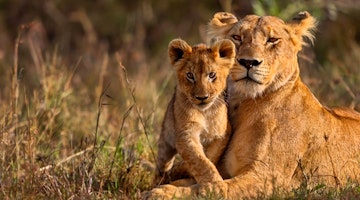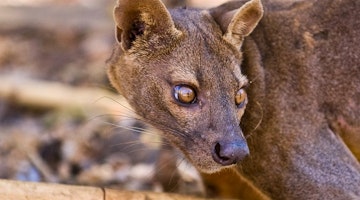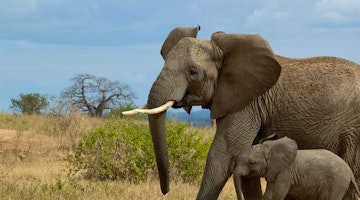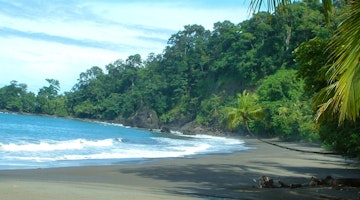Isalo, with its spectacular rock formations, diverse landscapes and extraordinary succulents (and its location on the RN7), is the most visited national park in Madagascar. It is a wonderful place for walking and hiking, and you can be rewarded with varied terrain, fascinating endemic plants, evidence of Bara culture and some of Madagascar’s unique wildlife and birds.
Habitat and landscape
Isalo National Park covers 81,500ha of the Isalo Massif, which rises from the flat grassy plains. The park encompasses an astonishing variety of terrain. The most prominent features are the sandstone massifs and jagged rock formations from the Jurassic, which, despite their inhospitable appearance, contain pockets of fire-resistant tapia forest.
Hidden away in this vast semi-arid landscape are a number of lush canyons with riparian forest, cool streams and waterfalls are surrounded by thick vegetation - despite its arid appearance, the Mangoky and Onilahy rivers originate in Isalo. Open grasslands and palm-fringed oases add to Isalo’s diversity. ??The famous 'Piscine Naturelle' (one of the natural pools in the park) rewards people who make the 1-hour walk from the car park with a refreshing dip in a stunning setting. The more demanding Namaza trail (4 – 6 hours) encompasses the Piscine Bleue, Piscine Noire and Casade des Nymphes. In the evening, visitors gather at La Fenêtre to watch the sunset through the natural window towards the southern end of the park.
Wildlife
While Isalo is justly esteemed for its landscapes, the quality of the light and its wonderful walking trails, its wildlife should not be underestimated. It only appears less plentiful than elsewhere because population densities are lower in this enormous protected area.?? In fact, Isalo has its fair share of reptiles and interesting frogs, as well as around 80 bird species.
Particular highlights include Madagascar partridge, White-throated rail, the localised Benson’s rock-thrush and, at night, the White-browed owl.?? Seasonally,you have a good chance of seeing lemurs at the campsite on the Namaza Trail where some bold ring-tailed and red-fronted brown lemurs can be encountered. The Canyon des Makis also offers a good opportunity to see Verreaux’s Sifaka. (Please note that in summer, while Tapia fruit are in season, mammalian wildlife disperses to sometimes remote parts of the massif).
When to go
Isalo is a year-round destination, but it can be very hot between November and March. January to March is the wettest time of year, although it is dry in comparison with the rest of the country. Between June and August, rain is virtually unknown, but nights can be cold. The elephant’s foot is generally in bloom in September and the first half of October. Visitors should have a reasonable level of fitness.
Location
Isalo is located on the well-maintained RN7, about 4 hours inland from Tulear. The park office is located the village of Ranohira, which is also the start of the walk to the Canyon des Makis. The car park for the Namaza Trail and the Piscine Naturelle is a few kilometres further south. The Maison de l’Isalo houses an interesting display on the geology and wildlife of the park, as well as a small exhibition about the surrounding people. Wildlife enthusiasts staying at the park for 3 nights should definitely use the opportunity to make a morning walk at Zombitse-Vohibasia Forest, 1 hour drive away.
Threats
Grass fires routinely set on the surrounding Horombe Plateau sometimes extend into the national park, In past years this has caused significant damage to certain parts of the protected area. As the sapphire deposits of Ilakaka nearby, become increasingly depleted, miners are turning their attention further afield. There have been documented cases of collectors apprehended with vehicles filled with 'Elephant's foot' pachypodium, in recent years.
Derek Schuurman
Travel Specialist
Looking for inspiration?
You'll find expert travel guides, holiday ideas and insider tips now on the Rainbow blog

Top 5 First Time Safari Destinations

10 Strange Animals and Where to Go to See them


Salar De Uyuni - The World's Largest Salt Flat


Top five South Africa Safari lodges

Sustainable Tourism In Corcovado National Park, Costa Rica

Why Choose Us?
Passionate travel experts
- We've been leading wildlife travel since our first South Africa tours over 25 years ago
- Our Travel Specialists have lived in their specialist area for years
- We work with local guides to immerse you deeper in our diverse range of experiences
Personal & tailor-made
- You'll speak to your own expert who'll share their first-hand knowledge
- We'll make your itinerary seamless with 24/7 emergency contact available
- Your Travel Specialist will listen to ensure you have the best chance of seeing the wildlife you love
Responsible by nature
- We take care to actively contribute to the conservation of environments we visit
- For select countries, we make a charitable donation on your behalf when you make your booking
- We've partnered with conservation experts and NGOs to curate responsible tours
For the latest travel advice from the Foreign, Commonwealth and Development Office check www.gov.uk/travelaware





